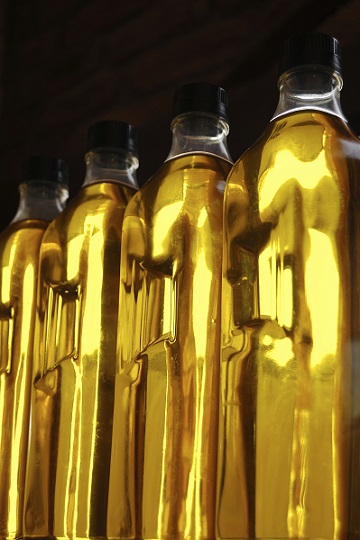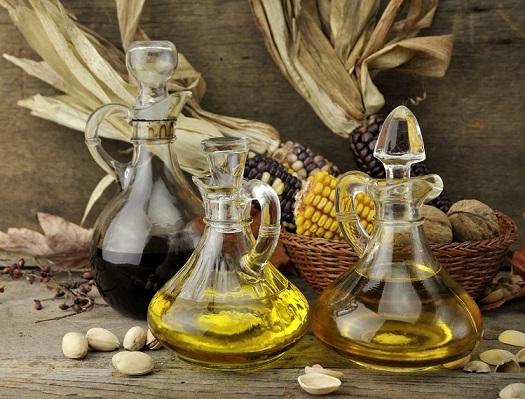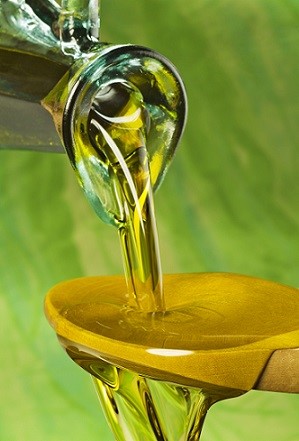
For acne, extra virgin olive oil ties with extra virgin coconut oil as the number one cooking oil you should roast potatoes with or drizzle on salad.
For one thing, this oil is bursting with vitamin E, the joint greatest nutrient for clogged pores. Secondly, olive oil is 70% oleic acid, a monounsaturated fat which calms chronic inflammation superbly.
Finally, there’s what olive oil isn’t; it’s free from chemical solvents, rancid fats, and mutated trans-fats thanks to humanity’s 3000-year-old knowledge of cold-pressing it.
Olive oil also contains only 15.5% polyunsaturated fat, compared to 66%, 58% and 55% in sunflower oil, soybean oil and corn oil. Polyunsaturated fats oxidise with impunity when eaten, draining your body of acne-clearing antioxidants.
But here’s something else you should know: olive oil is a highly overrated topical treatment for acne. Like coconut oil or papaya, the story changes completely when you put it on your skin.
The craze first kicked off with the Mediterranean fad diet, which is the touted saviour of heart health. Many experimental acne patients have theorised that olive’s oil’s nutritional goodness might translate superbly to the face, and another factor in the popularity is crafty advertising. Everyone knows that Italians, Spaniards, and Greeks use olive oil for everything; they rub it into their hands and feet, into their face as a moisturiser, into their hair for sleekness and shininess.
If you’ve ever visited the Mediterranean, then you’ll notice that their skin tone is fantastic. Now, acne patients everywhere are trying to mimic this.
Nevertheless, while some acne-banishing foods are equally effective when applied topically, such as strawberries or turmeric, olive oil is not one of them.
Power one – may fade away old acne scars

There’s no denying that olive oil has some decent powers, and the first is accelerating wound healing.
This 2014 study started promisingly, commenting in the introduction that olive is popular for wound cleansing in Iran. 24 male, 16 month old mice had all their fur shaved off, and small incisions were made in their skin. The experimental group had their wounds injected with oleuropein, the phenolic antioxidant behind many of olive oil’s heart health benefits.
7 days later, the distilled water accomplished barely anything, but oleuropein increased collagen deposition in the wound significantly, and advanced the pace of re-epithelisation. Collagen is the number one protein involved with wound healing, and importantly for us, this carries over into pimple healing, because they heal just like any standard wound.
The scientists thus concluded: “these results suggest that oleuropein accelerates skin wound healing in aged male Balb/c mice”. A second study from the same team again observed improved collagen deposition and more rapid re-epithelisation, and this time, more voluminous blood flow back into the wounds.
Read Annihilate Your Acne – get the ultimate diet and clear your acne permanently!
Oleuropein is accepted to be the signature compound of olive oil, so the signs are clearly positive, but will the stellar results apply to humans? Unless you’re a 16 month old male mouse, then the results aren’t enough for an instant recommendation. What’s more, oleuropein is one compound among hundreds. The great results could be scuppered if a substance like oleic acid turns out to slow wound healing instead. We’d be in better shape if we had studies on collagen and olive oil itself, but alas, we don’t.
Consider cocoa butter, for example. If you tested its natural ceramides on wound healing in isolation, you might conclude that cocoa butter is amazing for acne. But cocoa butter also scores 4/5 on the American Journal of Dermatology’s comedogenic scale, giving it a “high” chance of clogging your skin pores.
Power two – fantastic for vitamin E
That’s a weak positive then, and now we arrive at vitamin E, which is easily olive oil’s most promising feature. Extra virgin olive oil contains 10% of the RDI for vitamin E per tablespoon, which blows most other skincare oils out of the water.
Vitamin E is needed to prevent the oxidation of squalene, a fatty acid which forms 11% of sebum (oil). Oxidised squalene turns into squalene peroxide, perhaps the most ruthlessly efficient pore-clogging substance in nature.
Ordinarily, your body equips all squalene manufactured with strong vitamin E defences, but if your dietary intake is lacking, then applying vitamin E directly will mitigate some of the damage. What’s more, olive oil is rich in oleic acid, which is added to pharmaceutical skincare formulations to improve their penetration into the skin. The same will happen with vitamin E.
Recommended – the top 6 vitamins and minerals for acne-free skin
Sounds good? If olive oil was free from its negative qualities, it would be great enough for me to recommend it enthusiastically.
Argan oil and grapeseed oil are also bombshells of vitamin E, but many of my recommended topical treatments lack it, such as tea tree oil, honey and rose water. Note: read the full profile on grapeseed oil’s greatness here.
Power three – a possible natural sunscreen

Finally, we have some fairly decent studies on inflammation and sunlight defences.
Joining oleuropein as one of the best researched olive oil compounds ever is oleocanthal. This study concluded that 3.4 tablespoons contained enough oleocanthal to match the anti-inflammatory properties of 10% ibuprofen, while this study tested oral oleocanthal, and equalled ibuprofen once again.
This study meanwhile, analysed the little known olive oil compounds erythrodiol and beta-sitosterol. When applied topically to a painfully swollen mouse ear, they reduced the inflammatory swelling by 61.4% and 82.1% respectively. Oleuropein was also tested, and lowered the inflammatory swelling by 30%.
For acne, it’s a smart idea to strengthen your skin cells against sunlight, because while high exposure can wreak havoc on your skin, you also need moderate exposure to generate goodies like vitamin D, nitric oxide and mood-boosting endorphins.
This study found that olive oil significantly reduced the rate of UVB-induced cancer formation in mice, when applied both before and after UVB exposure. Olive oil was also compared to camellia oil, which had no benefits when applied using an identical propotol.
Another study was less positive, as in 32 human volunteers, neither olive oil nor glycerine increased the minimal erythral dose (MED) after 5 days of regular UV exposure, while petrolatum did succeed. The MED is a useful term to remember for skincare: it’s the lowest concentration of UVB radiation required to mutate and damage human skin cells. The higher your MED, the more resistant your acne is to inflammation from intense (or moderate) sunlight.
Vitamin E – the ultimate nutrient for clogged pores
Finally, this telling study observed another decrease in tumour formation when olive oil was rubbed in after UVB ray exposure. However, unlike the first study, applying olive oil prior to exposure didn’t work. Olive oil also suppressed a free radical called 9-OHdG, which is generated by sunlight upon contact with human skin cells (particularly in weak skin, by lesser amounts in strong skin). They concluded that “daily topical use of super virgin olive oil after sun bathing may delay and reduce UV-induced skin cancer development in human skin“.
Our conclusion then? Olive oil undoubtedly contains anti-inflammatory compounds, but again, the methodology is flawed; two of the positive UVB ray studies were conducted on mice, and the one human study produced starkly negative results.
Oleocanthal is also mysterious, because its studies were purely oral-based rather than topical. The beta-sitosterol study was promising, but conducted on mice skin yet again.
That said, we’re not blinkered by bias: the great results are repeated often enough that something is clearly happening.
The fatal flaw of olive oil
So why don’t I recommend topical olive oil for any acne patient?
Because of one simple reason: damage to the human skin barrier, most likely due to oleic acid. That’s a monounsaturated fatty acid responsible for many of olive oil’s famous heart health benefits, such as lowering LDL cholesterol. When consumed, oleic acid can clear acne indirectly by calming inflammation, particularly the vicious chemical interleukin-6 (study).
But when you apply oleic acid to the face, the story flips on its head. As we discussed earlier, oleic acid is a useful skin penetration enhancer, but unfortunately, this power works by destabilising the skin barrier.
Specifically, both olive oil and oleic acid increase trans-epidermal water loss (TEWL), the quantity of water that passes through the outer epidermis and into the atmosphere.
The higher your TEWL score, the dryer your skin becomes. Furthermore, according to this study of 36 mild to moderate acne patients, “the patients with AV exhibited markedly higher sebum secretion and greater TEWL“. The increase in TEWL was particularly noticeable for the severest acne patients.
While the mechanism is unclear, the study blamed an increase in the pore-clogging protein keratin. Oiliness can also increase in direct response to keratin.
The case against olive oil mounts
Why is this important? Firstly, olive oil is proven directly to damage the skin barrier:
ONE: in a study investigating several popular moisturising oils, sunflower seed oil improved skin hydration and barrier integrity, but olive oil significantly reduced barrier integrity after 4 weeks. The scientists commented that “topical treatment with olive oil significantly damages the skin barrier, and therefore has the potential to promote… atopic dermatitis“. Atopic dermatitis is an inflammatory skin condition with strong parallels to acne. Overall, they concluded that topical olive oil should be discouraged as a remedy.
TWO: some rats were treated to increase their TEWL levels. Sunflower seed oil reversed the increase, but olive oil had no benefit (study).
THREE: this study investigated the popular practise of mothers rubbing olive oil into their newborn baby’s skin as a moisturiser. Scientists were worried that the practise might do more harm than good, so they assigned 115 healthy babies to either olive oil, sunflower oil, or no oil twice daily for 4 weeks. While both oils improved skin hydration, they also delayed the development of skin barrier functions in infants which defend against water loss and harmful allergies and infections.
Then they discovered which compound was responsible: oleic acid, which forms 70% of olive oil’s total fats.
FOUR: this 2014 study applied oleic acid, glyceryl trioleate, and a mixture of the two to human skin, and concluded that pure OA inflected the most damage on TEWL and human skin barrier function.
FIVE: when oleic, linoleic, alpha-linolenic, and arachidonic acid were applied to human skin barriers, oleic acid led to the biggest deterioration in TEWL (study).
SIX: in this 2009 study, scientists had moved to the next level, debating precisely how oleic acid increases TEWL.
SEVEN: a study beginning with a telling quotation: “Oleic acid (OA) is well-known to affect the function of the skin barrier“. The scientists revealed that oleic acid damaged the function of ceramides, waxy fat molecules which protect the skin.
EIGHT: just 1 hour after application, a combination of oleic acid and propylene glycol increased trans-epidermal water loss significantly (study).
The very fat which makes olive oil such a nutritional powerhouse is clearly the exact opposite when you rub it into your skin.
Olive oil may be a pore-clogging nightmare

There are other flaws as well. Firstly, olive oil is a fat, and therefore carries an automatic risk of clogging your skin pores.
Olive oil itself is fairly safe, scoring a comfortable 2 on the American Journal of Dermatology’s comedogenic ratings. By contrast, coconut oil and cocoa butter score a risky 4 out of 5 each, which is why I strongly recommend against them.
Nevertheless, 2 still stands for a “moderately low” risk. Many tales from the internet speak of olive oil working like a charm for 5 days, only for new pimples to burst out of nowhere in completely new locations. That sounds suspiciously like new pores were being clogged and giving p.acnes bacteria fresh new breeding grounds. Grapeseed oil and jojoba oil also score a 2, but somehow seem to be safer.
What’s more, olive oil’s acne powers pale next to the anti-inflammatory powerhouse of aloe vera or the bacteria-slaying machine of royal jelly. Therefore, running the real risk of blocked pores is doubly pointless.
Also, while we’re here, remember this key difference: essential oils like tea tree and rose water are NOT fats. They are simply distillations of what is usually the plant’s leaves or petals into an ultra concentrated liquid. They carry no risk of clogging your skin pores compared to fat-based oils such also olive oil, coconut oil, or cocoa butter, which are dubbed as carrier oils.
The top 7 topical treatments for clearing acne naturally
Finally, there’s the looming risk of other sensitivities; this study followed a masseur, who ended up with red eczema on his hands after rubbing olive oil into a customer’s skin. The scientists also spotted skin sensitisation, which could have been caused by slow, insidious skin barrier damage.
Conclusion
Olive oil is excellent for roasting potatoes or pouring onto lettuce, but it fails miserably as a topical treatment. It might prevent inflammation from UVB radiation in sunlight and help old acne scars to heal, but these powers are too weak to counteract oleic acid’s skin barrier mayhem.
Theoretically, olive oil could be useful if your face is starved of precious vitamin E, If you’ve analysed your diet and found a great vitamin E shaped hole, then topical olive oil could succeed as an extra fast tool while your newly crafted master diet catches up.
However, it’s still made pointless by grapeseed oil, which is vitamin E heavy and oleic acid free. If you bought olive oil as a moisturiser but are now disappointed, then grapeseed oil or jojoba oil are far superior alternatives.
Judging by the testimonials and science we’ve just covered, I would advise against using olive oil for more than three days in a row.
NEXT: get the complete strategy for clearing acne naturally
Thanks for reading!